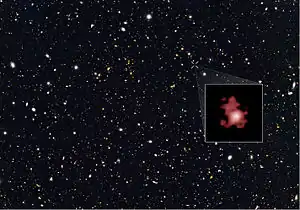جیان - ز۱۱ (کهکشان)
کهکشان جیان - ز۱۱ (به انگلیسی: GN-z11) یک کهکشان باانتقال به سرخ بالاست که در صورت فلکی خرس بزرگ پیدا شده، و تا امروز قدیمیترین و دوردستترین کهکشان شناخته شده در جهان قابل مشاهده است.[3] جیان - ز۱۱ دارای طیفبینی انتقال به سرخ بالای Z = ۱۱٫۱ است. این رقم که نشانگر فاصلهایاست که نور طی کرده تا به زمین و تلسکوپ فضایی هابل برسد فاصلهای حدود ۳۲ بیلیون (۳۲هزار میلیون) سال نوری از زمین است.[4] جیان - ز۱۱ بهگونهای که ما امروز آن را میبینیم نمای این کهکشان در ۱۳٫۴ بیلیون (۱۳٫۴ هزار میلیون) سال پیش ابن کهکشان است که وجود داشته، تنها ۴۰۰ میلیون سال پس از انفجار بزرگ مهبانگ.[5][6][7] دوری این کهکشان در میان سطح گستردهای از صاحبنظران (به اشتباه) ۱۳٫۴ بیلیون (۱۳٫۴ هزار میلیون) سال نوری برآورد شده بود. رقم انتقال به سرخ بالای Z = ۱۱٫۱ هم این کهکشان را در صدر فهرست فاصلهٔ کهکشانها قرار میدهد.[8]

| جیان - ز۱۱ | |
|---|---|
| دادههای مشاهده (J2000[1] مبدأ) | |
| صورت فلکی | صورت فلکی خرس بزرگ[1] |
| بعد | ۱۲h ۳۶m ۲۵٫۴۶s[1] |
| میل | ۳۱٫۴″ ۱۴′ +۶۲°[1] |
| انتقال به سرخ | ۱۱٫۰۹[2]< |
| نردبان فاصله کیهانی | ~۳٫۲×۱۰۱۰ ly |
| مشخصات | |
| ریختشناسی کهکشانها | کهکشان |
| جرم | ~۱۰×۱۰۹ M☉ |
کشف
این کهکشان توسط یک گروه بررسی متشکل از تیم بررسی دادههای کیهانی تلسکوپ فضایی هابل: مجمع بررسی میراث فراکهکشانی مادون قرمز عمیق تلسکوپ فضایی هابل (CANDELS شمع) و تلسکوپ فضایی اسپیتزر رصدخانه بزرگ ریشهٔ عمیق بررسی-شمالی (GOODS-شمال) شناسایی شد.[9][10]
منابع
- "Hubble Team Breaks Cosmic Distance Record - Fast Facts". HubbleSite. March 3, 2016. STScI-2016-07. Retrieved March 4, 2016.
- http://arxiv.org/pdf/1603.00461.pdf Jump up to: a b c d Oesch, P. A.; Brammer, G.; van Dokkum, P.; et al. (March 1, 2016). "A Remarkably Luminous Galaxy at z=11.1 Measured with Hubble Space Telescope Grism Spectroscopy" (PDF). arXiv:1603.00461.
- http://news.discovery.com/space/galaxies/hubble-finds-most-distant-oldest-galaxy-ever-160303.htm Klotz, Irene (March 3, 2016). "Hubble Spies Most Distant, Oldest Galaxy Ever". Discovery News. Retrieved March 3, 2016.
- http://phenomena.nationalgeographic.com/2016/03/03/astronomers-spot-most-distant-galaxy-yet-at-least-for-now/ "Astronomers Spot Most Distant Galaxy—At Least For Now". Phenomena. Retrieved March 4, 2016. "Yep, it took 13.4 billion years for light from the galaxy to zoom through the universe and collide with the Hubble Space Telescope. But that doesn’t mean the galaxy is 13.4 billion light-years away. The universe has been expanding in the meantime, meaning GN-z11 is actually much, much farther from Earth than that.
- http://arxiv.org/abs/1603.00461 Oesch, P. A. ; Brammer, G. ; van Dokkum, P. ; et al. (March 1, 2016). "A Remarkably Luminous Galaxy at z=11.1 Measured with Hubble Space Telescope Grism Spectroscopy". arXiv:1603.00461.
- http://www.bbc.co.uk/news/science-environment-35721734 Amos, Jonathan (March 3, 2016). "Hubble sets new cosmic distance record". BBC News. Retrieved March 3, 2016.
- مشارکتکنندگان ویکیپدیا. «GN-z11». در دانشنامهٔ ویکیپدیای انگلیسی.
- http://www.nytimes.com/aponline/2016/03/03/science/ap-us-sci-farthest-galaxy.html?_r=0 "Astronomers Spot Record Distant Galaxy From Early Cosmos", The New York Times (by the Associated Press), March 3, 2106; "GN-z11: Astronomers push Hubble Space Telescope to limits to observe most remote galaxy ever seen", Australian Broadcasting Corporation, March 4, 2016.
- http://hubblesite.org/newscenter/archive/releases/2016/07/full/ "Hubble Team Breaks Cosmic Distance Record - Full". HubbleSite.org. March 3, 2016. STScI-2016-07. Retrieved March 3, 2016.
- http://www.spacetelescope.org/news/heic1604/ "Hubble breaks cosmic distance record". SpaceTelescope.org. March 3, 2016. heic1604. Retrieved March 3, 2016.